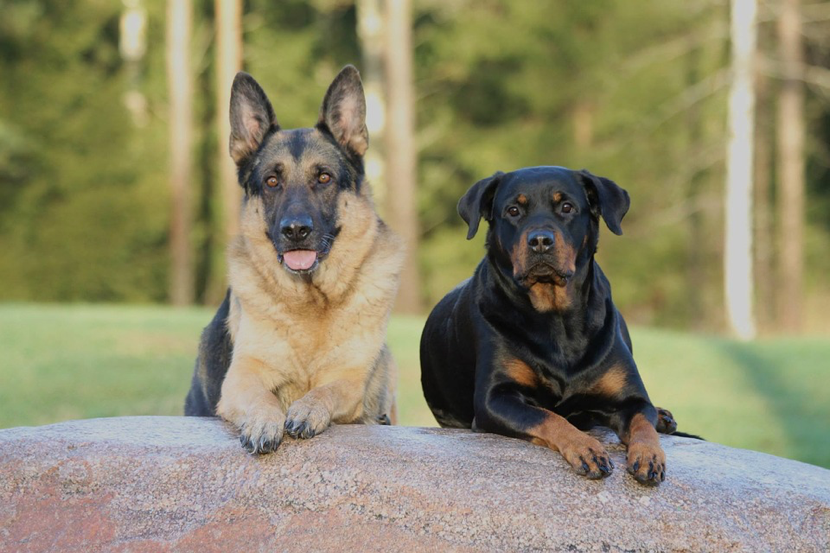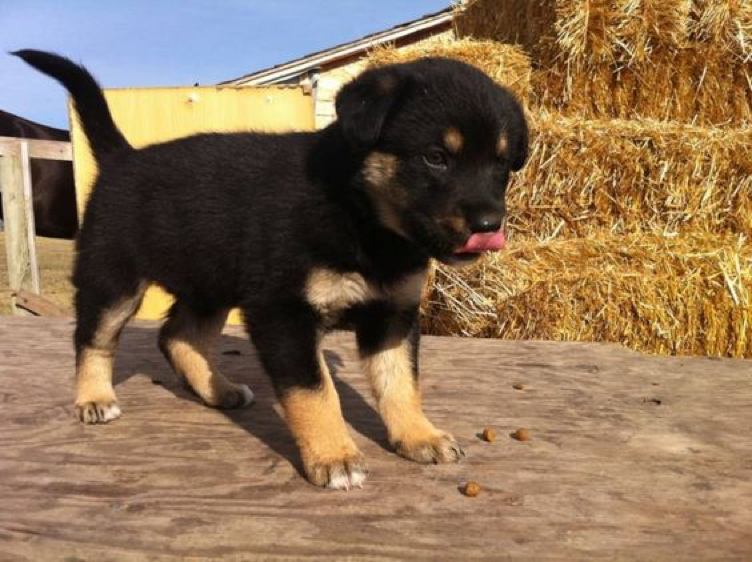A guide to owning a German Shepherd Rottweiler Mix
There are all kinds of mixed breed dogs in the world, each with their own unique and quirky names but in this guide we’ll be focusing on the German Shepard Rottweiler hybrid. There are a bunch of different names that these furry canines go by, including ‘Shepweiler’, ‘Rottweiler Shepard’ and even ‘Rotten Shepard’. Whatever you decide to call your new friend, it’s important that you know as much about them as possible before they join the family. Just like any dog, a German Shepard Rottweiler mix has a list of specific needs and requirements for a happy and healthy life.
Knowing the origins of your dog is also important and interesting to learn about, so we’re going to talk you through where your Shepweiler came from and how it’s become such a popular breed amongst dog lovers and trainers. Looking at the parents of a mix breed can tell you a lot about your four-legged friend and can give you a good indication of what to expect in terms of behaviour, health and trainability.
Every dog deserves a loving home so if you’re considering getting a German Shepherd Rottweiler mix it’s important to make sure that this breed is a good fit for you. Hopefully, after reading through this helpful guide you’ll have a better understanding of the breed and can decide whether or not it would make a good match for you.
What is a German Shepherd Rottweiler mix?
The result of a crossing between a purebred German Shepherd and a Rottweiler, the Shepweiler is a designer breed that was bred to combine the best elements of both its parent. The German Shepheard and the Rottweiler are among the most desirable breeds in the world and the combination of the two has resulted in a very popular pooch.
Shepweiler information:
- Dog Breed Group: Mixed Breed Dogs
- Weight: 75 to 115 pounds
Life expectancy: approximately 10-13 years
- Average cost: £500-£800
Colours: Ranging from blonde to black, depending on parent breed
- Average weight: 35-52kg
Average height: 56-68cm

Mixing two very distinctive dog breeds can often produce a number of potential risks but can also result in an amazing hybrid that is suited to all different types of people. To get a better idea of whether the Shepweiler’s temperament and personality is a match for you, it’s important to look at their origin and see what the parents of this pooch are bringing to the mix.
The Origins of a Shepweiler
Rottweiler
The Rottweiler belongs to a category of working dog breeds that were historically referred to as butchers’ dogs, as they were often used to pull meat carts to market. Known for their strength, Rottweilers are medium-large sized dogs with an average height of 56-69 cm and an average weight of 35-60kg.
These dogs are known for their tough exterior, which has been cultivated over decades from their training as working dogs. When trains and cars eventually replaced the need for droving, the Rottweiler was no longer used for transporting stock but has retained its powerful physique and agility. In recent years they have been trained as guard dogs, rescue dogs and police dogs.
German Shepherd
The German Shepherd is much slimmer in stature than the Rottweiler, weighing on average 22-40kg and growing to 55-65cm tall. As members of the herding family of dogs, German Shepherds have been used for decades as a service dogs and are known for their strong devotion to their handler.
As well as their iconic appearance, German Shepherds are renowned for their intelligence and trainability, which in recent years has led many of them to careers as guide dogs, military dogs and even acting dogs. They are currently the second most popular breed of dog in the world and have found homes with all kinds of different owners around the world.
The temperament of a Shepweiler
Just like with any other type of mixed breed it can be hard to predict exactly what the temperament of a Shepweiler will be as we can only base it on the parent breeds. The reputation of its parent breeds means that the temperament of the Shepweiler often comes under a lot of scrutiny.
Both German Shepherds and Rottweilers are historically trained as guard dogs and have been bred to show aggression on command. This has led to a number of misconceptions, with many people often misunderstanding them.
German Shepherds have a deep-rooted sense of protection that will often cause them to become confrontational if they sense that their home is under threat. This can be an issue for family homes if you don’t properly train your dog. German Shepherds are highly intelligent and their aggression can be controlled and targeted, which is why they are often used as police dogs and military service dogs.
Much like their German cousins, Rottweilers are known to show aggression towards perceived intruders and other dogs, which has caused them to develop a negative stereotype within the media. There have been many cases where an untrained Rottweiler has attacked bystanders, which has often been down to a lack of dedication by their owner.
Despite the negative stereotypes it is important to remember that the aggression shown by these two parent breeds comes out of a desire to protect, and is easily controlled in a Shepweiler with proper training and devotion.

Image source: https://www.pinterest.co.uk/pi...
German Shepherd Rottweiler mix training
The amazing thing about Shepweilers is the very high level of intelligence they’ve inherited from their parent breeds, which means they’re very quick to learn and easy to train. Because of their natural temperament and instinct to protect it’s very important to get them socialising as soon as possible. You need to get your Shepweiler pup used to being around strangers and other dogs so it’s a good idea to immerse them in social areas. Having a lot of visitors come to the house to introduce themselves will help dull your puppy’s desire to protect.
It’s been shown that the best type of training for any guard dog breed revolves around reward-based techniques. It’s not a good idea to use punishment techniques due to their natural aggressive temperament, which can get stronger as a Shepweiler ages.
Grooming a Shepweiler
The level of grooming and rate at which you Shepweiler will shed is dependent on the more dominant parent genes.
If your pup inherits the beautiful thick coat of its German Shepherd it will require a lot more maintenance and will need to be brushed a couple of times a week to ensure a healthy coat. When shedding season comes around you’ll need to get the brush out even more often.
If your Shepweiler has the much shorter coat of a Rottweiler then you’re in luck and will only need to brush them about once a week. It’s still important to keep them well-groomed to improve blood flow and get rid of any dead skin or excess hair.
If you share our love for all pets and are considering enrolling in a dog grooming course, book a visit or download our brochure for more information. If you've already set up your own business, see how Groomarts can assist your business.

Image source: https://www.pinterest.co.uk/pi...
Shepweiler health
Much like many other mixed breed dogs, the Shepweiler is prone to a number of potential health problems or hereditary genetic issues. In many cases these problems won’t start to surface until much later in your pooch’s life, so it’s important to keep them active and healthy from a young age.
There are a series of conditions that can develop in larger mix breed dogs like the Shepweiler. These includes things such as hip dysplasia, joint problems, skin allergies and eye diseases[Eileen AC1] . Regular health checks and a healthy balanced diet are vital in maintaining long-lasting health in your dog.
Unfortunately both of the parent breeds of a Shepweiler are prone to hip dysplasia and joint problems, which means that it could be a very serious issue for your canine friend. Maintaining a healthy weight can help to reduce the effects of these conditions, so if you decide to adopt a Shepweiler be sure that they get a good amount of exercise and eat healthily.
Exercise requirements of a Shepweiler
Just like both of its parent breeds a Shepweiler is a very energetic and playful dog that loves to stay active. It’s important that your dog gets plenty of exercise so they can exert all of their built up energy. If this mix breed is kept from running around for too long then they may turn their attention to more destructive activities, so be sure to let them stretch their legs regularly.
The health benefits of exercise are particularly relevant to Shepweiler’s due to their predisposition to joint problems. Maintaining healthy joints and keeping your dog at a good weight are the best ways to minimise the risk of things like hip dysplasia.
Is a Shepweiler right for you?
If you spend a lot of time out of the house for long periods it may not be the best idea to get a Shepweiler as they require regular walks and potentially a lot of grooming. The size and temperament of Shepweilers means they need a good amount of space to exercise and grow, which means they may not be suited to smaller homes or apartments.
If you have the time and are willing to put effort into training your dog properly a Shepweiler can make a perfect family dog. Their potentially aggressive temperament may see like cause for concern but if you train them from a young age and instil good socialising skills into them, they provide the perfect balance of affection and protection.
